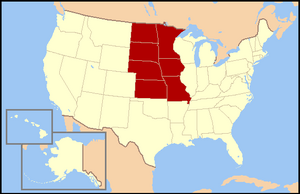West North Central states facts for kids
Quick facts for kids
West North Central
|
|
|---|---|
|
|
|
 |
|
| Composition | |
| Metropolitan areas |
|
| Largest city | Minneapolis-St. Paul, MN |
| Area | |
| • Total | 507,913 sq mi (1,315,490 km2) |
| Population
(2020)
|
|
| • Total | 21,616,921 |
| • Density | 42.56028/sq mi (16.432617/km2) |
The West North Central states are a group of states in the central United States. The U.S. Census Bureau officially recognizes this area.
This region includes seven states: Iowa, Kansas, Minnesota, Missouri, Nebraska, North Dakota, and South Dakota. It forms the western part of the larger Midwest region. The Mississippi River largely separates it from the eastern Midwest states.
People often call the West North Central states the "Farm Belt" or the "Agricultural Heartland." This is because farming is a very important part of the economy here. Since the early 1990s, this area has had low unemployment rates. It is also known for having many affordable homes.
Contents
People and Places in the West North Central States
How Many People Live Here?
In 2020, the West North Central states had a total population of 21,616,921 people. This was a 5.4% increase from 2010. The region covers about 507,913 square miles (1,315,490 square kilometers) of land. On average, there are about 42.56 people living in each square mile.
States and Their Populations
The table below shows the population and land area for each state in the West North Central region, based on the 2020 census.
| State | 2020 Population | Land Area (sq mi) |
|---|---|---|
| Iowa | 3,190,369 | 56,272 |
| Kansas | 2,937,880 | 82,277 |
| Minnesota | 5,706,494 | 86,939 |
| Missouri | 6,154,913 | 69,709 |
| Nebraska | 1,961,504 | 77,354 |
| North Dakota | 779,094 | 70,700 |
| South Dakota | 886,667 | 77,116 |
Biggest Cities in the Region
Here are the ten largest cities in the West North Central states by population, according to the 2020 census.
| Rank | City | 2020 Population |
|---|---|---|
| 1 | Kansas City, Missouri | 508,090 |
| 2 | Omaha, Nebraska | 484,983 |
| 3 | Minneapolis, Minnesota | 434,341 |
| 4 | Wichita, Kansas | 390,780 |
| 5 | St. Louis, Missouri | 318,416 |
| 6 | St. Paul, Minnesota | 310,468 |
| 7 | St. Louis, Missouri | 292,601 |
| 8 | Lincoln, Nebraska | 292,201 |
| 9 | Des Moines, Iowa | 215,293 |
| 10 | Overland Park, Kansas | 197,783 |
Largest City Areas (Metropolitan Areas)
Metropolitan areas include a main city and its surrounding towns and suburbs. These are the largest metropolitan areas in the West North Central region as of 2020.
| 1 | Twin Cities (MN-WI) | 3,685,561 |
| 2 | St. Louis, MO-IL | 2,806,100 |
| 3 | Kansas City, Missouri-KS | 2,172,902 |
| 4 | Omaha, Nebraska-IA | 963,221 |
| 5 | Des Moines, Iowa | 721,326 |
| 6 | Wichita, Kansas | 649,230 |
| 7 | Springfield, Missouri | 473,702 |
| 8 | Quad Cities IA-IL (Davenport) | 376,502 |
| 9 | Lincoln, Nebraska | 340,954 |
| 10 | Duluth, MN-WI | 287,430 |
Presidential Elections in the West North Central States
This section looks at how the states in the West North Central region have voted in presidential elections over time. The table shows which candidate won the electoral votes in each state for different elections.
| Political Parties | |||||
| Democratic-Republican | Democratic | Republican | Liberal Republican | Populist | Progressive |
- Bold means the candidate won the overall election.
Images for kids
See also
 In Spanish: Centro Noroeste de Estados Unidos para niños
In Spanish: Centro Noroeste de Estados Unidos para niños






